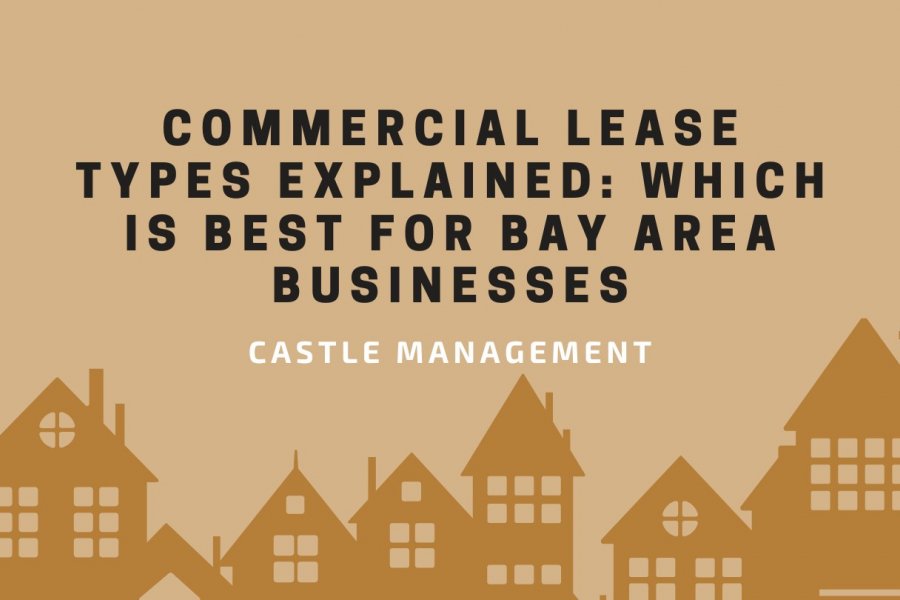
- Lease Type Shapes Profitability: Understanding commercial lease structures helps Bay Area landlords manage expenses, reduce risks, and secure predictable income.
- Market Knowledge Maximizes Returns: Each Bay Area region, from Silicon Valley to San Francisco, requires tailored lease strategies that align with tenant demand and property value.
- Balanced Agreements Build Stability: Choosing the right lease type ensures fair cost allocation, stronger tenant retention, and steady cash flow.
- Professional Management Simplifies Success: Hiring Castle Management provides expert guidance to structure leases that protect assets and optimize long-term performance.
One of the most crucial decisions a property owner can make is leasing a commercial property. Since the real estate market in the California Bay Area is competitive and complex, knowing the lease types is essential.
That is because the lease type determines monthly financial commitments, property responsibilities, operating costs, and how landlords and tenants will share long-term business risks.
The Bay Area is unique because of the diverse commercial landscapes it encompasses, including suburban retail hubs, Silicon Valley’s tech campuses, Oakland’s industrial corridors, and San Francisco’s financial district.
Landlords need to align lease agreements according to cost structures and special rental dynamics of each market sector. In this article, our team at Castle Management will discuss the common commercial lease types, the benefits and drawbacks for landlords, and suggest effective structures for different businesses in the Bay Area.
Learn How We Can Help You Maximize Your Investment’s Potential!
The Benefits of the Lease Structure in the Bay Area
Considering both residential and commercial real estate in the United States, the Bay Area is among the most expensive locations.
The rental rates here are higher because of the limited availability of land, high property taxes, increased demand from technology companies, and complex building codes. The lease structure is important for the foundation of financial planning here because it affects;
- The Property’s Value: The strength and type of lease agreements affect how investors assess commercial properties.
- Tenant Retention: Some industries prefer certain lease structures to help reduce turnover.
- Allocation of Expenses: This determines if the landlord or tenant will be responsible for costs such as seismic retrofitting or insurance premiums.
- Predicting Cash Flow: The reliability and stability of monthly incomes.

An Overview of Commercial Lease Types
1. Full-Service or Gross Lease
This is the type of lease where renters pay a fixed rent and landlords handle all the expenses concerning the property (maintenance, taxes, insurance, and utilities).
Pros:
- Higher Rent: Landlords can collect a premium base rent because the cost for everything is bundled.
- Simplified Relationship With Tenants: Renters will have fewer disputes with landlords over operating costs.
- Appealing to Renters: Tenants, such as small businesses, professional firms, and startups, are attracted to this lease type because it is predictable.
Cons:
- The Risks of Rising Costs: If there are increased costs, such as taxes, maintenance, or utilities, landlords bear them alone. This can negatively affect the cash flow.
- Efficiency Responsibility: If tenants use inefficient systems (e.g., appliances, HVAC), it will increase operating costs for landlords.
A gross lease is best for multi-tenant office buildings in downtown San Jose and San Francisco. However, landlords who choose this type of lease should strategically budget for fluctuations in operating expenses.
Discover the Benefits of Partnering With Castle Management
2. Modified Gross Lease
As the name implies, this is a modification of the gross lease. It combines the gross and net leases. With this lease, renters pay the base rent and specific operating expenses (janitorial costs or utilities), and landlords handle the rest.
Pros:
- Attractive to Renters: That is because it is not overwhelming and can be predictable.
- Flexible Negotiation: Depending on the tenant’s profile, landlords can adjust expenses.
- Balanced Cost Sharing: During fluctuating expenses, the exposure for landlords is lower.
Cons:
- Limited Expense Recovery: Although some expenses are shared, landlords can still have significant costs.
- Complex Administration: To prevent disputes, landlords who use this lease need clearer agreements.
A modified gross lease is best suited for creative office spaces and shared professional environments in Oakland and Berkeley.

3. Net Leases
There are different types of net leases depending on the level of expenses assigned to tenants.
A) Single Net Lease
In this arrangement, tenants pay rent and property taxes while the landlord handles maintenance and insurance. For landlords, the tax burden is reduced. However, they will still spend on insurance and maintenance. This type of lease is rare in the Bay Area and is often best for retail spaces and small offices.
Learn More About Castle Management!
B) Double Net Lease
With this lease, the tenant pays rent, taxes, and insurance while the landlord covers maintenance for the structural elements. It serves as a great relief for landlords, although they will still be responsible for structural maintenance. This is best for multi-tenant retail centers and suburban medical offices.
C) Triple Net Lease
In this lease, the tenant pays rent plus all property expenses (maintenance, insurance, and taxes), leaving landlords with predictable cash flow and minimal costs.
While it’s ideal for investors seeking steady returns, it can deter tenants due to unpredictable operating expenses, which causes a higher vacancy risk. Common in Bay Area industrial and retail properties, this lease type suits logistics firms and national retailers.

4. Percentage Lease
In this arrangement, the tenant pays the landlord a base rent and a percentage of gross sales.
Pros:
- Landlords will also share in the tenant’s successes.
- Since the rents are usually lower, it attracts more tenants (especially renters in competitive markets). Landlords and tenants can have aligned interests.
Cons:
- Landlords can not be sure of their income since it fluctuates with how the tenant’s business performs.
- It becomes a burden for the landlord to audit and monitor the tenant’s sales report.
A percentage lease is best for entertainment districts and shopping malls in Santana Row and San Francisco. Landlords enjoy it when renters have high sales volumes. However, careful oversight and clear tenant communication are necessary.
Discover Our Property Management Services!
5. Ground Lease
The tenant leases the land, then constructs a building. When the lease expires, the landlord becomes responsible for upgrades.
Pros:
- Landlords can acquire valuable assets in the long term.
- It requires minimal responsibilities from the landlord since tenants will handle operating and development duties.
- Landlords have stable, long-term tenants.
Cons:
- If the business is poorly managed, the immediate return on investment may be reduced.
- The benefits are delayed as the value improvement may not be realized for many years.
This lease type is suitable for national restaurant chains, gas stations, and hotels (near suburban developments and transit hubs).
Bottom Line
Landlords in the Bay Area should view lease types as a strategic financial decision. To maximize profitability and reduce risk, it’s important to align the lease type with your long-term investment goals, tenant profile, and property features.
Choosing the right lease structure helps secure long-term asset value and steady income. For expert guidance and support, consider hiring Castle Management to help you select and manage the best lease strategy for your property.
